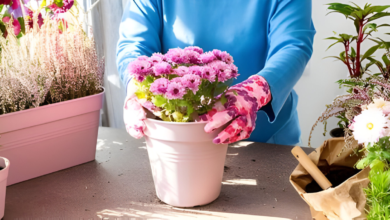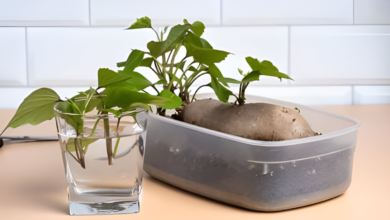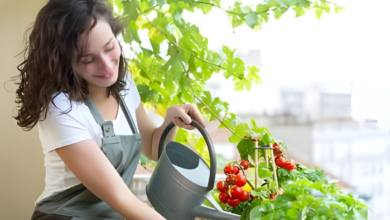How to Make a Flower Pot Using Plastic Bottles

Table of Contents:
- 1. Introduction
- 2. Benefits of Repurposing Plastic Bottles into Flower Pots
- 3. Tools and Materials Needed
- 4. Step-by-Step Guide to Repurposing Plastic Bottles into Flower Pots
- 5. Creative Painting and Decorating Ideas for Plastic Bottle Flower Pots
- 6. Using Plastic Bottles as Hanging Flower Pots
- 7. Upcycling Plastic Bottles into Self-Watering Flower Pots
- 8. Growing Different Types of Plants in Plastic Bottle Flower Pots
- 9. Tips for Maintaining Plastic Bottle Flower Pots
- 10. Environmental Impact of Repurposing Plastic Bottles
1. Introduction
I love finding ways to upcycle materials and turn them into something beautiful and useful. One of my favorite projects is making flower pots using plastic bottles. Not only is this a creative way to reduce waste, but it also allows you to personalize your garden with unique and eco-friendly planters. In this tutorial, I will guide you through the process of transforming plastic bottles into charming flower pots. By following these simple steps, you can elevate your garden décor and contribute to a greener environment. Let’s get started on this fun and rewarding DIY project!
2. Benefits of Repurposing Plastic Bottles into Flower Pots
I. Upcycling plastic bottles into flower pots is a sustainable practice that helps reduce plastic waste in the environment.
II. By repurposing plastic bottles, I can contribute to a cleaner planet by diverting plastic from landfills and oceans.
III. Turning plastic bottles into flower pots is a cost-effective way to add greenery to my home without spending extra money on traditional pots.
IV. The process of creating flower pots from plastic bottles allows me to unleash my creativity by customizing the pots with various designs and colors.
V. Plastic bottle flower pots are lightweight and easy to move around, making them convenient for rearranging plants or taking them outdoors for sunlight.
VI. Repurposing plastic bottles into flower pots promotes environmental awareness and encourages others to adopt sustainable practices in their daily lives.
VII. By choosing to make flower pots from plastic bottles, I am showcasing my commitment to sustainability and inspiring others to follow suit.
VIII. Utilizing plastic bottles as flower pots is a fulfilling DIY project that not only benefits the planet but also provides a sense of accomplishment and pride in reducing waste creatively.
3. Tools and Materials Needed
I will need the following tools and materials to make a flower pot using plastic bottles:
- Plastic Bottles
- Look for clean and empty plastic bottles in various sizes. The number of bottles will depend on the size of the flower pot you intend to make.
- Scissors
- A pair of sharp scissors will be necessary to cut the plastic bottles with precision.
- Marker
- A marker will help in marking where you need to cut the plastic bottles for the desired shape.
- Soil and Plants
- Choose the soil appropriate for the plants you want to grow in your flower pot. Select small plants or seeds to grow in the pot.
- Decorative Materials (Optional)
- You can gather decorative materials like paint, ribbons, stickers, or any other embellishments you wish to use to add a personal touch to your flower pot.
- Adhesive
- Depending on the decorations you choose, you might need adhesive like glue or tape to attach them securely to the flower pot.
- Watering Can
- Have a watering can ready to water your plants once they are in the flower pot.
- Protective Gear (Optional)
- If you prefer, wear gloves to protect your hands while working with scissors or any sharp edges on the plastic bottles.
By having these tools and materials prepared, I will be fully equipped to create a beautiful flower pot from recycled plastic bottles.
4. Step-by-Step Guide to Repurposing Plastic Bottles into Flower Pots
I’ll guide you through the process of turning plastic bottles into charming flower pots. Here’s a step-by-step approach:
- Gather Materials:
- Plastic bottles (varying sizes for different pot sizes)
- Scissors
- Marker or pen
- Potting soil
- Seeds or plants
- Preparation:
- Clean the plastic bottles thoroughly to remove any labels or residue.
- Determine the desired height for your flower pot and mark the cutting line on the bottle.
- Cutting the Bottle:
- Using scissors, carefully cut along the marked line. Ensure the edges are smooth to avoid any injuries.
- Punch Holes for Drainage:
- Make several small holes at the base of the bottle to allow water to drain properly. This is crucial for the plant’s health.
- Decorate (Optional):
- Get creative with decorating the bottle. You can paint it, wrap it with twine, or use stickers to give it a personalized touch.
- Planting:
- Fill the bottom of the bottle with a layer of small stones or gravel for additional drainage.
- Add potting soil, leaving enough space for the plant’s roots.
- Plant your seeds or transfer a small plant into the bottle.
- Maintenance:
- Place your newly made flower pot in a location that suits the plant’s light requirements. Remember to water it regularly and watch your plant grow in its upcycled home.
By following these simple steps, you can create eco-friendly flower pots from plastic bottles, adding a touch of green to your living space while reducing waste.
5. Creative Painting and Decorating Ideas for Plastic Bottle Flower Pots
When it comes to adding a personal touch to your plastic bottle flower pots, the options are endless. Here are some creative painting and decorating ideas to inspire you:
- Spray Painting: Use spray paint to give your plastic bottle flower pots a smooth and colorful finish. Choose vibrant colors that complement your plants and outdoor space. Remember to let each coat dry completely before adding another layer.
- Stenciling: Stencils are a fun way to add intricate designs to your flower pots. You can use geometric patterns, floral motifs, or even your initials. Place the stencil on the pot and use a small brush to fill in the design with acrylic paint.
- Decoupage: Decoupage involves decorating the flower pot with cut-out images or colorful paper. You can use botanical prints, newspaper clippings, or even tissue paper to create a unique look. Apply a layer of decoupage glue to the pot, arrange the paper cut-outs, and seal with another coat of glue.
- Drip Painting: Drip painting can create a modern and artistic look for your plastic bottle flower pots. Select two or three colors of acrylic paint and carefully drip them from the top of the pot. Rotate the pot to control the drips and create a stunning abstract design.
- Add Texture: Consider adding texture to your flower pots by using materials like twine, lace, or buttons. Secure the texture elements to the pot with strong glue or adhesive tape for a whimsical and tactile effect.
Get creative and experiment with different techniques to make your plastic bottle flower pots truly unique and eye-catching. Let your imagination run wild to transform these simple containers into beautiful pieces of art for your garden.
6. Using Plastic Bottles as Hanging Flower Pots
I find using plastic bottles as hanging flower pots to be a creative and eco-friendly way to display plants. Here’s how I repurpose plastic bottles for this purpose:
- Gather Materials: To start, I gather empty plastic bottles, scissors, a marker, some twine or string, and small plants or flowers.
- Preparing the Bottles: I mark a line around the bottle, usually about two-thirds of the way up from the base, and then cut along this line to create the container. I make sure to smooth out any rough edges.
- Adding Drainage Holes: Next, I carefully pierce a few small holes in the bottom of the bottle to allow for proper drainage. This step is essential for the health of the plants.
- Creating Hangers: To make the hanging mechanism, I cut two long pieces of twine and thread them through two holes on opposite sides of the bottle’s neck. I tie the ends together securely to form a loop for hanging.
- Planting the Flowers: After filling the bottle with soil, I plant my desired flowers or small plants. I make sure to choose varieties that do well in hanging pots.
- Watering and Maintenance: I water the plants as needed, ensuring not to overwater since excess water can stagnate in the container. Regularly check the soil’s moisture levels to keep the plants thriving.
By transforming plastic bottles into hanging flower pots, I not only breathe new life into these containers but also contribute to reducing plastic waste in the environment. It’s a simple yet impactful way to add greenery and beauty to any space while promoting sustainability.
7. Upcycling Plastic Bottles into Self-Watering Flower Pots
I learned a clever way to repurpose plastic bottles by turning them into self-watering flower pots. This method is not only eco-friendly but also practical for anyone looking to grow plants indoors or outdoors. Here is how you can transform plastic bottles into self-watering flower pots:
- Gather Materials:
- Plastic bottles (2-liter or smaller)
- Sharp scissors
- Potting soil
- Small plants or seeds
- Water
- Prepare the Plastic Bottles:
- Start by cutting the plastic bottle in half. The bottom half will be used as the pot, while the top half can be saved for future projects or recycled.
- Make a few small holes in the bottle cap to allow for water drainage.
- Assemble the Flower Pot:
- Fill the bottom half of the bottle with potting soil, leaving some space at the top.
- Plant your seeds or small plants in the soil, following the instructions for proper planting depth.
- Water the soil lightly before placing the top half of the bottle back on.
- Create the Self-Watering System:
- Fill the top half of the bottle with water, ensuring that the cap with drainage holes is securely in place.
- As the soil dries out, it will absorb water from the bottom, creating a self-watering effect that sustains the plant.
- Maintain Your Self-Watering Flower Pot:
- Monitor the water levels in the top half of the bottle and refill as needed.
- Place the flower pot in a location with adequate sunlight for your plant’s specific needs.
By upcycling plastic bottles into self-watering flower pots, I not only reduced waste but also created a simple and effective way to nurture plants in any space. Give this DIY project a try and enjoy watching your plants thrive!
8. Growing Different Types of Plants in Plastic Bottle Flower Pots
I recommend choosing plants that are suitable for the size of your plastic bottle flower pots. Here are some ideas for different types of plants you can grow:
- Herbs: Herbs like basil, mint, and parsley thrive in small containers. They can add a fresh aroma to your indoor or outdoor space.
- Succulents: Succulents are low-maintenance plants that can do well in plastic bottle flower pots. They come in various shapes and colors, adding diversity to your collection.
- Flowering Plants: Plants like pansies, petunias, and marigolds can bring vibrant colors to your garden or home. Make sure to provide sufficient sunlight for these plants to bloom.
- Vegetables: Plants like cherry tomatoes, peppers, and lettuce can be grown in larger plastic bottle flower pots. They can even be placed on balconies or patios for a mini vegetable garden.
Remember to choose plants that have similar light and water requirements when grouping them together in the same pot. It’s essential to provide adequate care, including watering, fertilizing, and pruning, to help your plants thrive in their plastic bottle flower pots. With a bit of creativity and careful attention, you can enjoy a beautiful and sustainable garden using recycled plastic bottles.
9. Tips for Maintaining Plastic Bottle Flower Pots
To ensure the longevity and beauty of your plastic bottle flower pots, here are some essential tips to keep in mind:
- Regular Cleaning and Maintenance: I recommend regularly cleaning your plastic bottle flower pots to prevent the build-up of dirt and algae. A simple solution of water and mild soap can do the trick.
- Drainage Holes: It’s crucial to have adequate drainage holes in your plastic bottle flower pots to prevent waterlogging. I suggest drilling a few holes at the bottom of the bottle to allow excess water to escape.
- Monitoring Watering: Overwatering can be detrimental to your plants. I suggest checking the moisture levels in the soil before watering again. Plastic bottles can retain moisture, so it’s important to water in moderation.
- Avoid Direct Sunlight: Placing your plastic bottle flower pots in direct sunlight for prolonged periods can cause them to deteriorate quicker. I recommend placing them in a spot with indirect sunlight to protect the plastic from damage.
- Protect from Extreme Temperatures: Extreme heat or cold can weaken the plastic material of your flower pots. It’s best to shelter them during severe weather conditions to prolong their lifespan.
- Inspect for Wear and Tear: Periodically check your plastic bottle flower pots for any signs of wear, such as cracks or discoloration. If you notice any damage, consider replacing the pot to avoid any harm to your plants.
- Repurpose Carefully: When repurposing plastic bottles as flower pots, ensure they are thoroughly cleaned and sanitized to prevent any contamination that could harm your plants.
By following these maintenance tips, you can enjoy beautiful and healthy plants in your plastic bottle flower pots for a long time.
10. Environmental Impact of Repurposing Plastic Bottles
I find it fascinating to consider the environmental impact of repurposing plastic bottles into flower pots. By upcycling these bottles instead of discarding them, I am contributing to waste reduction and promoting sustainability. Here are some key points to highlight:
- Reduction of Plastic Waste: Each plastic bottle that I repurpose into a flower pot is one less item adding to the ever-growing landfill problem. By reusing these bottles in a creative way, I am helping to reduce the amount of plastic waste that ends up polluting our environment.
- Conservation of Resources: Repurposing plastic bottles conserves the resources that would have been used to produce new plastic items. This includes saving energy and reducing the demand for raw materials, leading to a more sustainable future.
- Promotion of Recycling Culture: When I repurpose plastic bottles into flower pots, I am setting an example for others to follow. This simple act can inspire more people to get creative with recycling and motivate them to find innovative ways to reuse items that would typically be thrown away.
- Educational Opportunity: Transforming plastic bottles into flower pots can also be an educational opportunity. By learning about the environmental benefits of upcycling, I can spread awareness about the importance of waste reduction and encourage others to take similar actions.
Overall, repurposing plastic bottles into flower pots is not only a creative and fun DIY project but also a meaningful way to make a positive impact on the environment.




